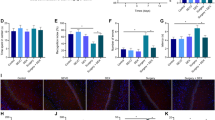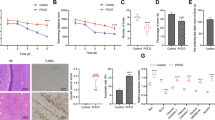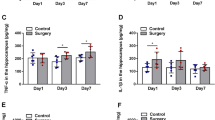Abstract
Rationale
Due to its anti-inflammatory effect, dexmedetomidine (DEX) can confer neuroprotection in postoperative neurocognitive disorders (NCD). Here, the mechanism responsible for this effect of DEX is rarely ascertained.
Objectives
Our research was implemented to figure out mechanism governing the protection of DEX against hippocampal neuroinflammation in postoperative NCD.
Methods
Exploratory laparotomy was applied for generating a postoperative NCD mouse model before bilateral hippocampal injection with microRNA (miR)-329-3p-agomir and intraperitoneal injection with DEX. Cognitive function of mice was evaluated by water maze test and fear conditioning test. Immunofluorescence was performed to assess microglial activation in hippocampus. After cell transfection and DEX treatment, mouse microglial cells (BV-2) were stimulated by lipopolysaccharide (LPS). IL-1β, IL-6, and TNF-α levels and the number of phagocytes were assessed by ELISA and flow cytometry. Dual-luciferase reporter assay was adopted to assess the relationship between miR-329-3p and CREB1.
Results
miR-329-3p expression was reduced in the postoperative NCD mice after DEX treatment. DEX treatment or miR-329-3p downregulation caused attenuated cognitive dysfunction and microglia activation as well as reduced IL-1β, IL-6, and TNF-α levels in the hippocampus of the postoperative NCD mice. Mechanistically, miR-329-3p inversely targeted CREB1 that activated IL1RA in LPS-induced BV-2 cells. DEX treatment, miR-329-3p inhibition, or CREB1 or IL1RA upregulation curtailed the release of proinflammatory proteins and the number of phagocytes in LPS-induced BV-2 cells.
Conclusions
Collectively, our data provided the novel insight of the neuroprotective mechanism of DEX in postoperative NCD pertaining to the miR-329-3p/CREB1/IL1RA axis.








Similar content being viewed by others
Data availability
The datasets generated/analyzed during the current study are available.
References
Anacker C, Hen R (2017) Adult hippocampal neurogenesis and cognitive flexibility - linking memory and mood. Nat Rev Neurosci 18(6):335–346. https://doi.org/10.1038/nrn.2017.45
Bai N, Zhang Q, Zhang W, Liu B, Yang F, Brann D, Wang R (2020) G-protein-coupled estrogen receptor activation upregulates interleukin-1 receptor antagonist in the hippocampus after global cerebral ischemia: implications for neuronal self-defense. J Neuroinflammation 17(1):45. https://doi.org/10.1186/s12974-020-1715-x
Bao Y, Zhu Y, He G, Ni H, Liu C, Ma L, Zhang L, Shi D (2019) Dexmedetomidine attenuates neuroinflammation in LPS-stimulated BV2 microglia cells through upregulation of miR-340. Drug Des Devel Ther 13:3465–3475. https://doi.org/10.2147/DDDT.S210511
Barrientos RM, Hein AM, Frank MG, Watkins LR, Maier SF (2012) Intracisternal interleukin-1 receptor antagonist prevents postoperative cognitive decline and neuroinflammatory response in aged rats. J Neurosci 32(42):14641–14648. https://doi.org/10.1523/JNEUROSCI.2173-12.2012
Dai XJ, Li N, Yu L, Chen ZY, Hua R, Qin X, Zhang YM (2015) Activation of BV2 microglia by lipopolysaccharide triggers an inflammatory reaction in PC12 cell apoptosis through a toll-like receptor 4-dependent pathway. Cell Stress Chaperones 20(2):321–331. https://doi.org/10.1007/s12192-014-0552-1
Dodds C, Allison J (1998) Postoperative cognitive deficit in the elderly surgical patient. Br J Anaesth 81(3):449–462. https://doi.org/10.1093/bja/81.3.449
Du X, Yu J, Mi W (2018) The effect of dexmedetomidine on the perioperative hemodynamics and postoperative cognitive function of elderly patients with hypertension: study protocol for a randomized controlled trial. Medicine (baltimore) 97(43):e12851. https://doi.org/10.1097/MD.0000000000012851
Erion JR, Wosiski-Kuhn M, Dey A, Hao S, Davis CL, Pollock NK, Stranahan AM (2014) Obesity elicits interleukin 1-mediated deficits in hippocampal synaptic plasticity. J Neurosci 34(7):2618–2631. https://doi.org/10.1523/JNEUROSCI.4200-13.2014
Evered LA, Silbert BS (2018) Postoperative cognitive dysfunction and noncardiac surgery. Anesth Analg 127(2):496–505. https://doi.org/10.1213/ANE.0000000000003514
Evered L, Silbert B, Knopman DS, Scott DA, DeKosky ST, Rasmussen LS, Oh ES, Crosby G, Berger M, Eckenhoff RG, Nomenclature Consensus Working G (2018) Recommendations for the nomenclature of cognitive change associated with anaesthesia and surgery-2018. Anesthesiology 129(5):872–879. https://doi.org/10.1097/ALN.0000000000002334
Feng X, Valdearcos M, Uchida Y, Lutrin D, Maze M, Koliwad SK (2017) Microglia mediate postoperative hippocampal inflammation and cognitive decline in mice. JCI Insight 2(7):e91229. https://doi.org/10.1172/jci.insight.91229
Fidalgo AR, Cibelli M, White JP, Nagy I, Maze M, Ma D (2011) Systemic inflammation enhances surgery-induced cognitive dysfunction in mice. Neurosci Lett 498(1):63–66. https://doi.org/10.1016/j.neulet.2011.04.063
Hovens IB, Schoemaker RG, van der Zee EA, Absalom AR, Heineman E, van Leeuwen BL (2014) Postoperative cognitive dysfunction: involvement of neuroinflammation and neuronal functioning. Brain Behav Immun 38:202–210. https://doi.org/10.1016/j.bbi.2014.02.002
Kotekar N, Kuruvilla CS, Murthy V (2014) Post-operative cognitive dysfunction in the elderly: A prospective clinical study. Indian J Anaesth 58(3):263–268. https://doi.org/10.4103/0019-5049.135034
Lei D, Sha Y, Wen S, Xie S, Liu L, Han C (2020) Dexmedetomidine may reduce IL-6 level and the risk of postoperative cognitive dysfunction in patients after surgery: a meta-analysis. Dose Response 18(1):1559325820902345. https://doi.org/10.1177/1559325820902345
Li H, Zhang X, Chen M, Chen J, Gao T, Yao S (2018) Dexmedetomidine inhibits inflammation in microglia cells under stimulation of LPS and ATP by c-Fos/NLRP3/caspase-1 cascades. EXCLI J 17:302–311. https://doi.org/10.17179/excli2017-1018
Li R, Lai IK, Pan JZ, Zhang P, Maze M (2020) Dexmedetomidine exerts an anti-inflammatory effect via alpha2 adrenoceptors to prevent lipopolysaccharide-induced cognitive decline in mice. Anesthesiology 133(2):393–407. https://doi.org/10.1097/ALN.0000000000003390
Lin X, Chen Y, Zhang P, Chen G, Zhou Y, Yu X (2020) The potential mechanism of postoperative cognitive dysfunction in older people. Exp Gerontol 130:110791. https://doi.org/10.1016/j.exger.2019.110791
Liu Y, Ma L, Gao M, Guo W, Ma Y (2016) Dexmedetomidine reduces postoperative delirium after joint replacement in elderly patients with mild cognitive impairment. Aging Clin Exp Res 28(4):729–736. https://doi.org/10.1007/s40520-015-0492-3
Liu J, Lin M, Qiao F, Zhang C (2021) Exosomes derived from lncRNA TCTN2-modified mesenchymal stem cells improve spinal cord injury by miR-329-3p/IGF1R axis. J Mol Neurosci. https://doi.org/10.1007/s12031-021-01914-7
Lu Y, Xu X, Dong R, Sun L, Chen L, Zhang Z, Peng M (2019) MicroRNA-181b-5p attenuates early postoperative cognitive dysfunction by suppressing hippocampal neuroinflammation in mice. Cytokine 120:41–53. https://doi.org/10.1016/j.cyto.2019.04.005
Mao L, Zeng Q, Su W, Song M, Li J, Xie M (2021) Elevation of miR-146a Inhibits BTG2/BAX Expression to Ameliorate Postoperative Cognitive Dysfunction Following Probiotics (VSL#3) Treatment. Mol Neurobiol 58(7):3457–3470. https://doi.org/10.1007/s12035-021-02330-z
Nakamura N, Davis K, Yan J, Sloper DT, Chen T (2020) Increased estrogen levels altered microRNA expression in prostate and plasma of rats dosed with sex hormones. Andrology 8(5):1360–1374. https://doi.org/10.1111/andr.12780
Oh SH, Choi C, Noh JE, Lee N, Jeong YW, Jeon I, Shin JM, Kim JH, Kim HJ, Lee JM, Kim HS, Kim OJ, Song J (2018) Interleukin-1 receptor antagonist-mediated neuroprotection by umbilical cord-derived mesenchymal stromal cells following transplantation into a rodent stroke model. Exp Mol Med 50(4):1–12. https://doi.org/10.1038/s12276-018-0041-1
Qian XL, Zhang W, Liu MZ, Zhou YB, Zhang JM, Han L, Peng YM, Jiang JH, Wang QD (2015) Dexmedetomidine improves early postoperative cognitive dysfunction in aged mice. Eur J Pharmacol 746:206–212. https://doi.org/10.1016/j.ejphar.2014.11.017
Safavynia SA, Goldstein PA (2018) The role of neuroinflammation in postoperative cognitive dysfunction: moving from hypothesis to treatment. Front Psychiatry 9:752. https://doi.org/10.3389/fpsyt.2018.00752
Sanders RD, Xu J, Shu Y, Januszewski A, Halder S, Fidalgo A, Sun P, Hossain M, Ma D, Maze M (2009) Dexmedetomidine attenuates isoflurane-induced neurocognitive impairment in neonatal rats. Anesthesiology 110(5):1077–1085. https://doi.org/10.1097/ALN.0b013e31819daedd
Sprung J, Schulte PJ, Knopman DS, Mielke MM, Petersen RC, Weingarten TN, Martin DP, Hanson AC, Schroeder DR, Warner DO (2019) Cognitive function after surgery with regional or general anesthesia: a population-based study. Alzheimers Dement 15(10):1243–1252. https://doi.org/10.1016/j.jalz.2019.06.4949
Su X, Meng ZT, Wu XH, Cui F, Li HL, Wang DX, Zhu X, Zhu SN, Maze M, Ma D (2016) Dexmedetomidine for prevention of delirium in elderly patients after non-cardiac surgery: a randomised, double-blind, placebo-controlled trial. Lancet 388(10054):1893–1902. https://doi.org/10.1016/S0140-6736(16)30580-3
Sun W, Zhao J, Li C (2020) Dexmedetomidine provides protection against hippocampal neuron apoptosis and cognitive impairment in mice with Alzheimer’s disease by mediating the miR-129/YAP1/JAG1 axis. Mol Neurobiol 57(12):5044–5055. https://doi.org/10.1007/s12035-020-02069-z
Terrando N, Monaco C, Ma D, Foxwell BM, Feldmann M, Maze M (2010) Tumor necrosis factor-alpha triggers a cytokine cascade yielding postoperative cognitive decline. Proc Natl Acad Sci U S A 107(47):20518–20522. https://doi.org/10.1073/pnas.1014557107
Tu Y, Liang Y, Xiao Y, Lv J, Guan R, Xiao F, Xie Y, Xiao Q (2019) Dexmedetomidine attenuates the neurotoxicity of propofol toward primary hippocampal neurons in vitro via Erk1/2/CREB/BDNF signaling pathways. Drug Des Devel Ther 13:695–706. https://doi.org/10.2147/DDDT.S188436
Vorhees CV, Williams MT (2006) Morris water maze: procedures for assessing spatial and related forms of learning and memory. Nat Protoc 1(2):848–858. https://doi.org/10.1038/nprot.2006.116
Wang WX, Wu Q, Liang SS, Zhang XK, Hu Q, Chen QH, Huang HJ, Xu L, Lou FQ (2018) Dexmedetomidine promotes the recovery of neurogenesis in aged mouse with postoperative cognitive dysfunction. Neurosci Lett 677:110–116. https://doi.org/10.1016/j.neulet.2018.03.043
Wang YP, Li HQ, Chen JX, Kong FG, Mo ZH, Wang JZ, Huang KM, Li XN, Yan Y (2020) Overexpression of XIST facilitates cell proliferation, invasion and suppresses cell apoptosis by reducing radio-sensitivity of glioma cells via miR-329–3p/CREB1 axis. Eur Rev Med Pharmacol Sci 24(6):3190–3203. https://doi.org/10.26355/eurrev_202003_20686
Wei W, Sun Z, He S, Zhang W, Chen S (2021) Protective role of dexmedetomidine against sevoflurane-induced postoperative cognitive dysfunction via the microRNA-129/TLR4 axis. J Clin Neurosci 92:89–97. https://doi.org/10.1016/j.jocn.2021.07.057
Wu X, Fu S, Liu Y, Luo H, Li F, Wang Y, Gao M, Cheng Y, Xie Z (2019) NDP-MSH binding melanocortin-1 receptor ameliorates neuroinflammation and BBB disruption through CREB/Nr4a1/NF-kappaB pathway after intracerebral hemorrhage in mice. J Neuroinflammation 16(1):192. https://doi.org/10.1186/s12974-019-1591-4
Xie B, Zhou H, Zhang R, Song M, Yu L, Wang L, Liu Z, Zhang Q, Cui D, Wang X, Xu S (2015a) Serum miR-206 and miR-132 as Potential Circulating Biomarkers for Mild Cognitive Impairment. J Alzheimers Dis 45(3):721–731. https://doi.org/10.3233/JAD-142847
Xie H, She GM, Wang C, Zhang LY, Liu CF (2015b) The gender difference in effect of sevoflurane exposure on cognitive function and hippocampus neuronal apoptosis in rats. Eur Rev Med Pharmacol Sci 19(4):647–657
Xiong B, Shi Q, Fang H (2016) Dexmedetomidine alleviates postoperative cognitive dysfunction by inhibiting neuron excitation in aged rats. Am J Transl Res 8(1):70–80
Xu J, Dong H, Qian Q, Zhang X, Wang Y, Jin W, Qian Y (2017) Astrocyte-derived CCL2 participates in surgery-induced cognitive dysfunction and neuroinflammation via evoking microglia activation. Behav Brain Res 332:145–153. https://doi.org/10.1016/j.bbr.2017.05.066
Yang W, Kong LS, Zhu XX, Wang RX, Liu Y, Chen LR (2019) Effect of dexmedetomidine on postoperative cognitive dysfunction and inflammation in patients after general anaesthesia: A PRISMA-compliant systematic review and meta-analysis. Medicine (baltimore) 98(18):e15383. https://doi.org/10.1097/MD.0000000000015383
Yang T, Velagapudi R, Terrando N (2020) Neuroinflammation after surgery: from mechanisms to therapeutic targets. Nat Immunol 21(11):1319–1326. https://doi.org/10.1038/s41590-020-00812-1
Yazit NAA, Juliana N, Das S, Teng N, Fahmy NM, Azmani S, Kadiman S (2020) Association of micro RNA and postoperative cognitive dysfunction: a review. Mini Rev Med Chem 20(17):1781–1790. https://doi.org/10.2174/1389557520666200621182717
Yirmiya R, Goshen I (2011) Immune modulation of learning, memory, neural plasticity and neurogenesis. Brain Behav Immun 25(2):181–213. https://doi.org/10.1016/j.bbi.2010.10.015
Yu X, Liu S, Li J, Fan X, Chen Y, Bi X, Liu S, Deng X (2015) MicroRNA-572 improves early post-operative cognitive dysfunction by down-regulating neural cell adhesion molecule 1. PLoS ONE 10(2):e0118511. https://doi.org/10.1371/journal.pone.0118511
Zhang R, Zhang Q, Niu J, Lu K, Xie B, Cui D, Xu S (2014) Screening of microRNAs associated with Alzheimer’s disease using oxidative stress cell model and different strains of senescence accelerated mice. J Neurol Sci 338(1–2):57–64. https://doi.org/10.1016/j.jns.2013.12.017
Zhang Z, Li W, Jia H (2021) Postoperative effects of dexmedetomidine on serum inflammatory factors and cognitive malfunctioning in patients with general anesthesia. J Healthc Eng 2021:7161901. https://doi.org/10.1155/2021/7161901
Zhao Z, Ma L, Li Y, Zhang Q, Wang Y, Tai Y, Wang Q (2021) MiR-124 protects against cognitive dysfunction induced by sevoflurane anesthesia in vivo and in vitro through targeting calpain small subunit 1 via NF-kappaB signaling pathway. Adv Clin Exp Med 30(7):701–709. https://doi.org/10.17219/acem/134740
Zhou C, Zhu Y, Liu Z, Ruan L (2016) Effect of dexmedetomidine on postoperative cognitive dysfunction in elderly patients after general anaesthesia: a meta-analysis. J Int Med Res 44(6):1182–1190. https://doi.org/10.1177/0300060516671623
Author information
Authors and Affiliations
Contributions
JQC and XXJ designed the study. YTZ and ZZS collated the data, carried out data analyses, and produced the initial draft of the manuscript. JZ contributed to drafting the manuscript. QD and BRW contributed to revising the manuscript. All authors have read and approved the final submitted manuscript.
Corresponding author
Ethics declarations
Conflict of interest
The authors declare no competing interests.
Additional information
Publisher's note
Springer Nature remains neutral with regard to jurisdictional claims in published maps and institutional affiliations.
Supplementary Information
Below is the link to the electronic supplementary material.
Rights and permissions
About this article
Cite this article
Chen, J., Ding, Q., Jiao, X. et al. Dexmedetomidine attenuates hippocampal neuroinflammation in postoperative neurocognitive disorders by inhibiting microRNA-329-3p and activating the CREB1/IL1RA axis. Psychopharmacology 239, 2171–2186 (2022). https://doi.org/10.1007/s00213-022-06091-y
Received:
Accepted:
Published:
Issue Date:
DOI: https://doi.org/10.1007/s00213-022-06091-y




